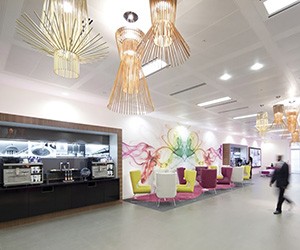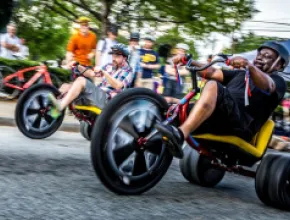Remember when the typical conference program consisted of one session after another, with a single speaker statically addressing a mass of attendees seated theater-style?
It’s safe to say those days are quickly becoming a thing of the past, with today’s conference attendees expecting (and even demanding) to meet in less formal ways—emphasizing collaboration, innovative spaces and technology, and even fresh air. The times they are a changin’, and all for the better from this reporter’s perspective, after speaking to several industry experts.
“There has been a cultural shift in the way we meet,” says Mark Cooper, CEO for the International Association of Conference Centres (IACC). “You can definitely see a change [across the board].”
Cooper notices, among other trends, organizations breaking down hierarchical barriers to foster ideas from all staff members, with a lot less emphasis on seniority.
“When you do that, the environments need to change, too,” he explains, “and not just be designed for one speaker addressing everyone [in the traditional way].”
A New Generation
Cooper also sees the rising Millennial generation of meeting planners and attendees playing a huge role in the sea change of conference learning styles and venue design, an opinion echoed by most conference insiders we spoke with.
“Millennials are driving change in the location and design of venues,” says Alastair Stewart, managing director of etc.venues in the U.K., which operates 14 non-residential, purpose-driven centers. “They are happy with public sector transport, using Uber over owning a car, see technology as an extension of their right arm, intolerant of slow and outdated technology, and quick to share their views of venues over social media. Food preferences are likely to be for all-day grazing rather than formal meals, with a focus on quality and sustainability.
“When it comes to learning, the style is increasingly collaborative, with cabaret seating preferred and engagement with the speaker continuous and interactive through apps such as sli.do,” he says. “Learning durations have shortened, partly driven by generational preferences and partly by [corporations] seeking to cut the overall costs by reducing course durations and encouraging delegates to make their own overnight arrangements.”
Stewart believes that urbanization is a key trend in conference center learning as well, strongly driven by the Millennial generation and its preference for ample options when it comes to lodging, transport and numerous dining and entertainment choices following a day of meetings. He adds that etc.venues has witnessed tri-fold growth over the past eight years, spurred by this trend, and now hosts 700,000 yearly delegates at its 14 venues—and that other conference centers are taking heed as well.
“In the U.S., Convene is growing rapidly with a specialized urban venue concept,” Stewart says. ”In France and other European countries Chateauform has developed a City model and in Australasia Cliftons is the major brand. These “challenger” brands are taking market share off hotel groups as they move quickly with modern, well-designed facilities that are making some of the older hotels and residential venues look like yesterday’s product.”
Fresh Approaches
Another seismic shift in conference meetings—whether at venues set in bustling downtowns or at remote rural settings—is getting groups into less-formal settings, the great outdoors included.
Kapellerput, a highly innovative venue and estate sprawling across 25 acres in the southern portion of the Netherlands, is an overseas conference center among IACC’s many Euro members that are helping change the “cookie-cutter” perception of conference properties.
The unique venue couldn’t be much more “outside the box,” hosting unexpected workshop subjects ranging from sheep herding and fencing to ice-carving, plus unusual spaces like its KABAN treehouse venue—partially perched over water and home to two boardrooms and alfresco areas as well.
“We need to think more holistically and create meeting environments where our clients feel comfortable to work, learn and exchange experience and ideas.” says Jeu Bressers, Kapellerput’s director. “The meeting environment is much more than the sum of rooms, bedrooms, beamers [projectors] and meals. It is the total experience that counts.
“A lot of [today’s] facilities are still based on the way Baby Boomers used to learn: in one direction, inactive and without fun. [That includes] boring teaching environments with chairs and tables in a row or square,” he continues. “Today’s meeting environment should be inspirational. We need exciting places to interact.”
In the current event landscape, Bressers opines that top conference venues must not only stand out from other meeting sites, they must stand out in general.
“We are not only competing with hotels or the other conference centers,” he says, “competition also includes funky office environments and all kinds of ‘blurring concept’ places where meetings are blended with coffee drinking, culture and fun—even peoples’ homes.”
IACC has also helped changed the conference mold with its aforementioned Chateauform member grouping, mostly comprised of stupendous country estates across Europe that have been transformed into compelling conference centers. Ellie Tsarantanis, Chateauform’s Swiss-based digital communications director, has seen huge changes in meetings held across venues in the past five or six years alone.
“Planners are asking for more informal spaces for activities; more informal as well as more high-tech,” she says. “At Chateauform we’ve created meeting room seating areas as well as an activity room, with tables that move and walls you can write on. We’ve also created more open spaces for people to meet and talk.”
Techie Teamwork
And the Millennial crowd—aka Generation Y—is clearly an influencer, according to Tsarantanis, who says they are definitely welcoming more attendees in the 28-35-year age range, and that Chateauform has even created a sub-brand known as Campus with Gen Y in mind. There are currently three Campus venues in Paris, with a focus on sporting activities, lighter and healthier foods, and high-tech options; to that end, a new interactive iWall boasting nine connected screens has been a big hit for groups seeking to brainstorm.
“Collaborative tech has been around for a bit but not done particularly well,” IACC’s Cooper remarks. In addition to the iWall, he says that recent tools like sli.do have improved the playing field, allowing participants to easily engage in polling and Q&A sessions via their iPhones. Anonymity is an option, boosting fresh input from delegates who might not want to raise their hand and vote in a packed session.
Other trendy tech at modern conference gatherings includes the Catchbox from PSAV, a soft and tossable dice-shaped microphone that is more fun and less problematic than the traditional wired mic. It also fits the trend toward more-casual learning and communication.
Convening Stateside
Cooper has seen major Millennial impact in the U.S. as well, where he says the most recent site from Convene is guided strongly by research done on “Gen Y” attendees.
Located in Midtown Manhattan at 237 Park Ave., and set for takeoff this summer, the cutting-edge venue definitely places an emphasis on the informal, with sleek but comfortable spaces aimed at fostering creative collaboration. Groups can go well beyond a traditional meet-up here, with elements such as a display cooking area (and on-site executive chef), gallery spaces and cushy lounge seating.
“It even has a ‘space within a space’ designed for corporate retreats,” Cooper adds, referring to The Club, highlighted by a fireplace, eye-catching wall decor and customizable lighting to set any mood.
Elsewhere stateside, Cooper expresses enthusiasm over OFFSITE New York and OFFSITE Chicago, day venues that like Convene seem to be aimed at concurrently fostering creativity and comfort. The New York site is particularly impressive; a spacious three-story new-build created solely with meetings in mind and located in Midtown Manhattan.






